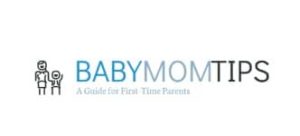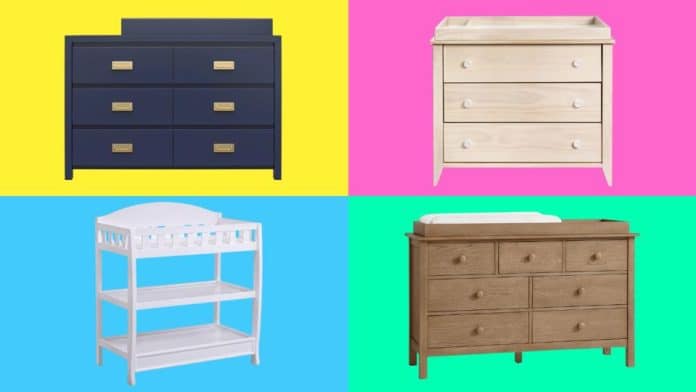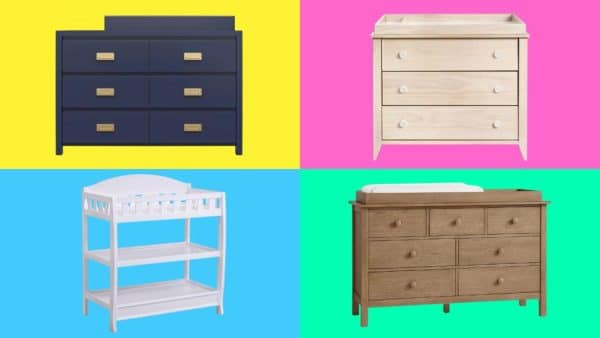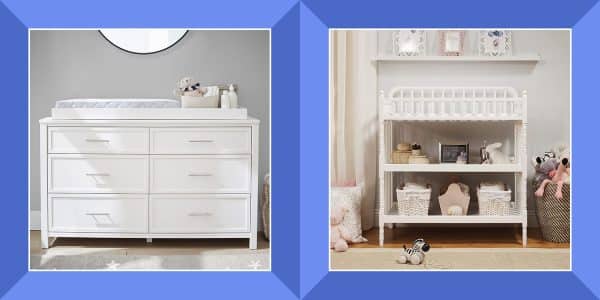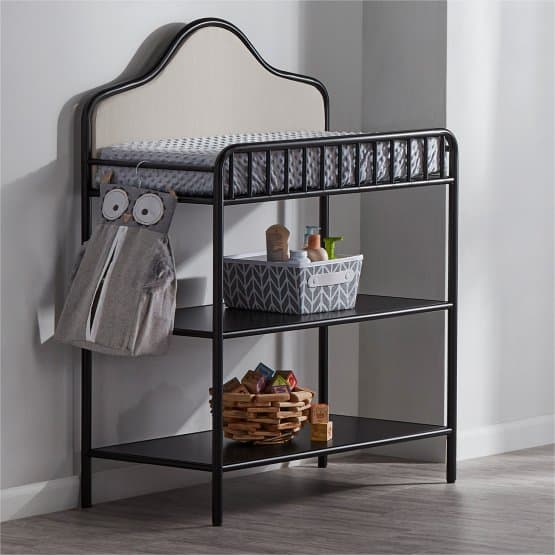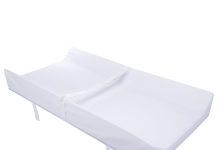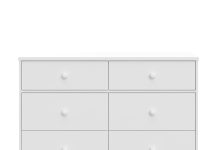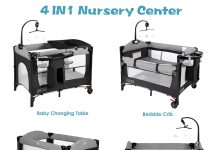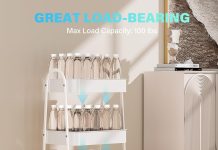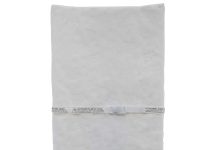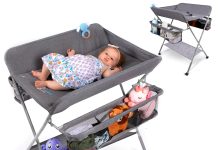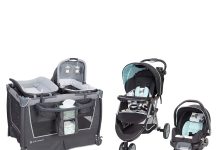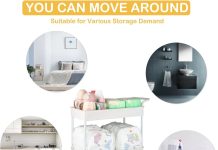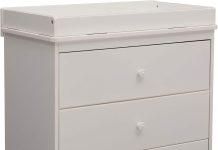Having a baby can be an overwhelming experience, filled with joy and excitement. As we prepare our homes for the arrival of our little ones, one essential item we need to consider is a baby changing table. But with so many options available, it can be confusing to decide which one is right for us. In this article, we will explore the different types of baby changing tables, helping us make an informed choice that suits our needs, style, and budget.
This image is property of www.homestratosphere.com.
Review contents
Standard baby changing tables
Design and features
Standard baby changing tables are designed as a dedicated piece of furniture specifically for changing diapers and caring for infants. They typically consist of a flat surface with raised edges to prevent the baby from rolling off, and some models may also include a safety strap for added security. These tables are usually made of sturdy materials such as wood or plastic and come in various designs and colors to match different nursery decor styles.
Benefits
One of the key benefits of standard baby changing tables is their stability and durability. They provide a secure and comfortable place for caregivers to change diapers without worrying about the safety of the baby. Additionally, these tables often come with built-in shelves or drawers, allowing for convenient storage of diapers, wipes, and other essential baby items. The ample surface area also provides enough space to keep additional supplies within reach, making it easier for caregivers to focus on the task at hand.
Drawbacks
While standard baby changing tables offer a range of benefits, they can also have some drawbacks. One of the main concerns is the space they occupy. These tables can be quite large and may not be suitable for small nurseries or homes with limited space. Additionally, as the baby grows, they may become more active and resistant to staying on the table, posing a potential safety risk. Lastly, purchasing a standard changing table may not be the most cost-effective option, especially if it is needed for a short period of time or if the caregiver prefers a more versatile solution.
Popular brands
Some popular brands that offer standard baby changing tables include Stokke, DaVinci, Graco, and Delta Children.
Wall-mounted baby changing tables
Space-saving design
Wall-mounted baby changing tables are an excellent option for those with limited space. These tables are designed to be mounted directly onto the wall, saving valuable floor space in the nursery or bathroom. They can be folded up when not in use, providing a sleek and compact solution for diaper changes.
Installation considerations
When considering a wall-mounted baby changing table, it is essential to ensure that the wall can support the weight of the table and the baby. Proper installation and secure mounting are crucial for safety purposes. It is recommended to consult a professional or follow the manufacturer’s instructions carefully to ensure a secure and stable installation.
Benefits
The most obvious benefit of wall-mounted baby changing tables is their space-saving design. They are ideal for small nurseries or bathrooms where floor space is limited. Additionally, these tables can be easily folded up and tucked away when not in use, allowing for more flexibility in the room layout. The height of these tables can also be adjusted to accommodate different caregivers, ensuring their comfort during diaper changes.
Drawbacks
One potential drawback of wall-mounted changing tables is their fixed position. Once installed, they cannot be easily moved or repositioned, which may limit flexibility in the nursery design in the long term. Furthermore, installation can be more complex compared to other types of changing tables, requiring drilling into the wall and ensuring proper support.
Popular brands
Popular brands that offer wall-mounted baby changing tables include Koala Kare, Boon, ECR4Kids, and Rubbermaid.
Foldable baby changing tables
Portability and storage
Foldable baby changing tables are designed to be easily portable and stored away when not in use. These tables typically feature a foldable design that allows them to be compactly folded into a smaller size, making them convenient for travel or for families with limited space.
Design variations
Foldable baby changing tables come in various designs, including models that fold vertically or horizontally. Some may feature a stand-alone structure, while others may be designed to be placed on top of existing furniture. The materials used for these tables can vary, with options ranging from lightweight plastic to sturdier wood construction.
Benefits
The portability and compactness of foldable baby changing tables make them a popular choice for families on the go or those living in smaller spaces. They can be easily folded and stored in a closet or car trunk, allowing caregivers to have a dedicated changing area wherever they may be. The foldable design also means that these tables can be quickly set up and put away, saving time and effort.
Drawbacks
One drawback of foldable baby changing tables is that they may not be as sturdy or durable as other types of changing tables. The folding mechanisms and lightweight construction may not provide the same level of stability and security as a standard or wall-mounted table. Additionally, the limited surface area of foldable tables may make it challenging to store extra supplies or keep them within reach during diaper changes.
Popular brands
Popular brands that offer foldable baby changing tables include Skip Hop, Bumbo, Summer Infant, and Badger Basket.
Chest of drawers with built-in changing tables
Dual functionality
Chest of drawers with built-in changing tables combine the functionality of a changing table with the storage capacity of a chest of drawers. These units typically feature a designated changing area on top, complete with raised edges and safety straps, while the drawers below provide ample space for organizing baby essentials.
Benefits
The primary benefit of a chest of drawers with a built-in changing table is its dual functionality. It offers caregivers a dedicated space for diaper changes while also providing valuable storage for clothing, diapers, and other baby items. This combination helps to maximize space efficiency in the nursery and keeps everything within easy reach during diaper changing sessions. The drawers can also transition into regular storage once the baby outgrows the need for a changing table, extending the usefulness of the furniture.
Drawbacks
One potential drawback of chest of drawers with built-in changing tables is their size and weight. These units tend to be larger and heavier than standalone changing tables, which may make moving or rearranging the nursery more challenging. Additionally, the drawers may not be as easily accessible during diaper changes, requiring caregivers to navigate around the changing area to retrieve items. Care should also be taken to ensure the stability of the changing area and the safety of the baby, as any weight placed on the top should not compromise the overall structure.
Popular brands
Popular brands that offer chest of drawers with built-in changing tables include Babyletto, Pottery Barn Kids, Babymod, and Evolur.
This image is property of assets.babycenter.com.
Convertible baby changing tables
Versatility
Convertible baby changing tables are designed to adapt to the changing needs of the child as they grow. These tables often feature a removable changing top, allowing them to be transformed into a regular dresser or other functional piece of furniture once the diaper-changing stage is over.
Growth with the child
One of the main benefits of convertible baby changing tables is their ability to grow with the child. By removing the changing top, the table can be repurposed for different stages of the child’s life, such as a dresser, a bookshelf, or a desk. This versatility not only extends the lifespan of the furniture but also provides a cost-effective solution for parents.
Benefits
The primary benefit of convertible baby changing tables is their long-term usability. They can be a worthwhile investment for parents who are looking for furniture that can adapt to their child’s changing needs and grow with them. By eliminating the need to purchase a separate dresser or storage solution, convertible tables can help save money and minimize waste. They also promote sustainability by reducing the number of items that end up in landfills.
Drawbacks
One potential drawback of convertible baby changing tables is their initial cost. These tables tend to be more expensive than traditional changing tables, reflecting their added functionality and versatility. Additionally, the conversion process may require some effort and time, depending on the specific design of the table, which may not be ideal for parents seeking a quick and straightforward diaper-changing solution.
Popular brands
Popular brands that offer convertible baby changing tables include Babyletto, Storkcraft, Million Dollar Baby Classic, and DaVinci.
Portable changing mats
Convenience and versatility
Portable changing mats provide a convenient and versatile solution for caregivers who are constantly on the move. These mats are typically made of soft, cushioned materials and feature a waterproof surface for easy cleaning. They can be easily rolled up or folded, allowing for compact storage and hassle-free transportation.
Design variations
Portable changing mats come in various designs and sizes to accommodate different preferences and needs. Some models feature integrated pockets or compartments for storing diapers and wipes, while others are more basic and focus solely on providing a clean and comfortable surface for diaper changes. The materials used can range from fabric to vinyl or even disposable options.
Benefits
One of the main benefits of portable changing mats is their portability and convenience. They can be easily carried in a diaper bag or attached to a stroller, ensuring that caregivers always have a clean and hygienic surface to change diapers while on the go. These mats are also versatile and can be used on various surfaces, such as public restroom changing stations or even on the floor. They are especially useful in situations where traditional changing tables are not available or not preferred.
Drawbacks
One drawback of portable changing mats is their limited storage capacity. Unlike other types of changing tables or stations, these mats typically do not have built-in storage compartments, making it necessary to carry additional diaper bags or organizers. Additionally, the lack of raised edges on the mat may pose a challenge when dealing with more active or wiggly babies, as it may be more difficult to prevent them from rolling off the mat during diaper changes.
Popular brands
Popular brands that offer portable changing mats include Skip Hop, Boppy, Munchkin, and JJ Cole.
This image is property of specials-images.forbesimg.com.
DIY baby changing tables
Customization options
DIY baby changing tables provide a unique opportunity for caregivers to create a personalized and custom-made changing station. By building their own table, parents can choose the design, materials, and features that best suit their preferences and needs. This allows for a truly tailored solution that can blend seamlessly with the nursery decor.
Affordability
One significant advantage of DIY baby changing tables is the potential for cost savings. By sourcing materials and building the table themselves, parents can avoid the higher price tags associated with ready-made furniture. This can be particularly beneficial for those on a tight budget or seeking a more affordable option.
Safety precautions
While DIY baby changing tables offer customization and affordability, safety should be a top priority. It is crucial to follow proper construction techniques, utilize sturdy materials, and ensure the integrity and stability of the table. Parents should also consider incorporating safety features such as raised edges, safety straps, and non-toxic finishes to create a safe changing environment for their baby.
Benefits
The main benefit of DIY baby changing tables is the opportunity for customization. Caregivers can design a table that perfectly fits their needs and preferences, ensuring that it not only meets the functional requirements for diaper changes but also complements the overall aesthetic of the nursery. Additionally, DIY projects can be a fun and rewarding experience, allowing parents to showcase their creativity and craftsmanship.
Drawbacks
The primary drawback of DIY baby changing tables is the time and effort required to build and assemble the table. DIY projects may involve researching plans, sourcing materials, and dedicating the necessary time for construction. This option may not be suitable for parents with limited time, lack of tools or woodworking knowledge, or those who prefer a faster and more convenient solution.
Hybrid or multi-purpose baby changing tables
Combining different functionalities
Hybrid or multi-purpose baby changing tables combine various functionalities into a single piece of furniture. These tables often incorporate additional features, such as a crib, a dresser, a playard, or even a bathing station. By combining these different elements, caregivers can maximize space efficiency and minimize the need for separate pieces of furniture.
Benefits
The primary benefit of hybrid or multi-purpose baby changing tables is their ability to provide multiple functionalities in one compact unit. This helps optimize space in the nursery and allows caregivers to have all the necessary baby care essentials within easy reach. By eliminating the need for separate furniture items, these tables can also be a cost-effective solution.
Drawbacks
One potential drawback of hybrid or multi-purpose baby changing tables is their size and weight. Combining various functionalities into a single unit may result in a larger and heavier piece of furniture compared to standalone changing tables, cribs, or dressers. This can make moving or rearranging the nursery more challenging. Additionally, the incorporation of multiple elements may limit customization options and restrict certain features or designs.
Popular brands
Popular brands that offer hybrid or multi-purpose baby changing tables include Graco, Sorelle, Dream On Me, and Simmons Kids.
This image is property of hips.hearstapps.com.
Built-in baby changing tables
Integration with existing furniture
Built-in baby changing tables are designed to seamlessly integrate into existing furniture or fixtures. These tables typically feature a fold-down or pull-out design, allowing them to be discreetly hidden away when not in use. They are commonly found in cribs, dressers, or bathroom countertops.
Design considerations
When considering a built-in baby changing table, it is crucial to ensure that the existing furniture or fixture can support the weight and provide a stable platform for diaper changes. Care should be taken to consider the size, height, and accessibility of the changing table within the overall layout of the nursery or bathroom.
Benefits
One of the main benefits of built-in baby changing tables is their space-saving design. By utilizing existing furniture or fixtures, they can help maximize space efficiency in the nursery or bathroom. These tables are often discreet and blend seamlessly into the surrounding decor, contributing to a clean and organized aesthetic. Additionally, built-in tables eliminate the need for separate furniture items, reducing clutter and allowing caregivers to focus on the baby.
Drawbacks
One potential drawback of built-in baby changing tables is their limited adaptability. Once installed, they are not easily movable or removable, making it difficult to modify or reposition the changing area. This lack of flexibility may not be ideal for caregivers who prefer to have a more versatile or portable solution. Additionally, the integration of the changing table into existing furniture or fixtures may require professional installation or modification, adding extra cost and effort.
Popular brands
Popular brands that offer built-in baby changing tables include IKEA, Babyletto, Storkcraft, and Pottery Barn Kids.
Baby changing tables with storage
Organizational features
Baby changing tables with storage are designed to provide dedicated space for organizing and storing essential baby items. These tables often include built-in shelves, drawers, or compartments, allowing caregivers to keep diapers, wipes, clothing, and other supplies within easy reach during diaper changes.
Benefits
The primary benefit of baby changing tables with storage is their organizational capability. By incorporating dedicated storage solutions into the changing table, caregivers can keep all necessary items close at hand and neatly organized. This helps optimize efficiency during diaper changes and allows for a smoother caregiving experience. The additional storage space can also reduce clutter in the nursery and minimize the need for separate storage furniture.
Drawbacks
One potential drawback of baby changing tables with storage is their size. The inclusion of storage features may result in a larger and bulkier changing table, which may not be ideal for smaller nurseries or homes with limited space. Additionally, the available storage compartments may have limited capacity, requiring additional storage solutions.
Popular brands
Popular brands that offer baby changing tables with storage include Delta Children, Badger Basket, South Shore Furniture, and Athena Baby Furniture.
In conclusion, there are various types of baby changing tables available, each with its own set of design, features, benefits, and drawbacks. Standard tables provide a dedicated space for diaper changes and often come with built-in storage. Wall-mounted tables save space and can be folded up when not in use. Foldable tables offer portability and storage convenience. Chest of drawers with built-in changing tables combine dual functionality. Convertible tables provide versatility and can grow with the child. Portable changing mats offer convenience and versatility on the go. DIY tables allow for customization and affordability, with proper safety precautions. Hybrid or multi-purpose tables combine different functionalities. Built-in tables integrate with existing furniture. Tables with storage provide organizational features. Caregivers can choose the type of changing table that best suits their needs, space limitations, and personal preferences, ensuring a comfortable and efficient diaper-changing experience for both the baby and the caregiver.
This image is property of www.homestratosphere.com.
